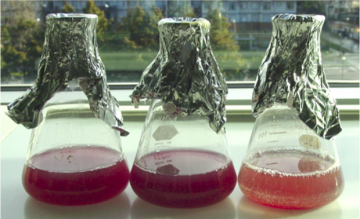
Could we efficiently generate electricity through photosynthesis like a plant, store energy organically, use components that do not harm the environment and use up carbon dioxide while doing it? Sounds good but how could we get there?
Meet the purple bacteria.

Purple bacteria get energy from the sun through photosynthesis like plants.
Purple bacteria can live without oxygen.
Like plants, purple bacteria actually consume CO2, a green house gas, in the process of generating energy from sunlight.
Some photosynthetic bacteria are thermophiles, they like very warm environments.
Put these qualities together and you have a remarkable creature whose biochemistry traps photons, fixes carbon and remains stable at temperatures that would degrade many proteins.

Tom Beatty, a microbiologist at UBC, and ECE’s John Madden, have worked together for ten years developing a technology that uses everything they have learned about plant photosynthesis, as well as purple bacteria, to harvest and store the energy from the sun. Along with former student and Professor at the University of South Florida, Arash Takshi, they have filed a patent, The Electrochemical Photovoltaic Cell, that describes the energy generation and storage possibilities of the technology. Now they are moving the research even further by incorporating the heat-loving properties of purple bacteria that will help to stabilize the solar cell. The team has recently gained support from Genome British Columbia’s Strategic Opportunities Fund to continue exploring how best to use the photosynthetic proteins found in purple bacteria to harvest sunlight.
“Our work fills a gap by directly converting sunlight to electricity, using green components and without any CO2 emission.”

The money from Genome BC aims to demonstrate photosynthetic proteins as inexpensive, efficient and environmentally sustainable components of solar cells. The team will use what they learn from purple bacteria to re-engineer photosynthetic light-harvesting and electron transfer pathways in a novel way and mine the genetic material from thermophiles to stabilize bio-photovoltaic devices. Ultimately, they would like to use biophotovoltaic devices to create inexpensive solar cells whose production consumes carbon dioxide.
There are great opportunities, but also big challenges. The photosynthesis process is very efficient at capturing light, but losses a lot of energy in the process. To make the process energy efficient, electron pathways in the proteins need to be modified – a step that remains to be proven. It also remains to be seen if the thermal stability common to some bacteria can be transferred to an energy efficient version. Work is being carried out by Daniel Jun, a PhD student in Microbiology, and Ali Mahmoudzadeh in ECE. Stay tuned!
Find out more:
Genome British Columbia is a catalyst for the life sciences cluster on Canada’s West Coast. Working with governments, academia and industry across sectors such as forestry, fisheries, agriculture, environment, bioenergy, mining and human health, the goal of the organization is to generate social and economic benefits for British Columbia and Canada.
